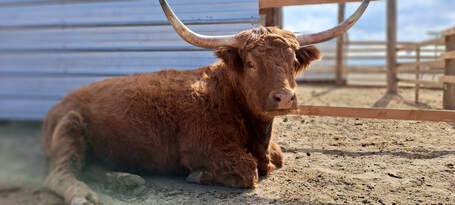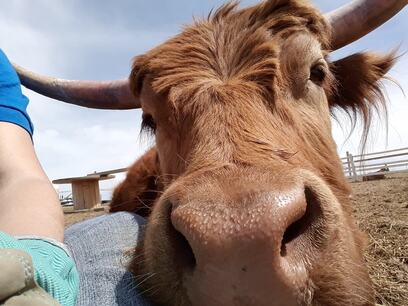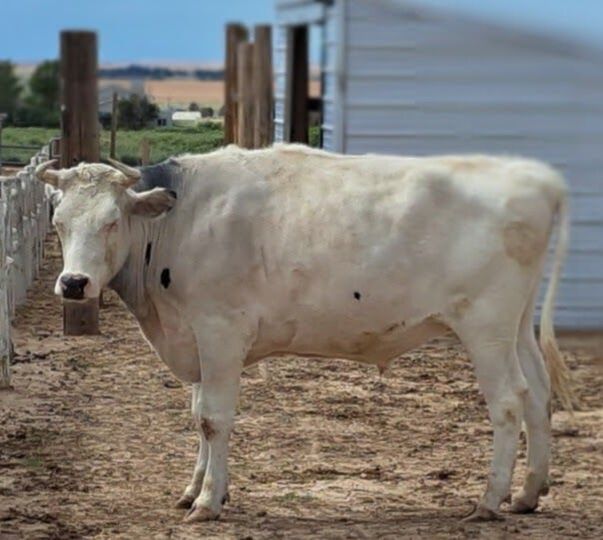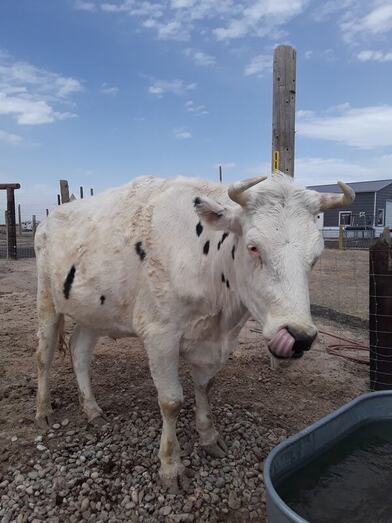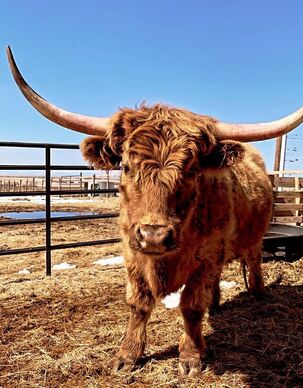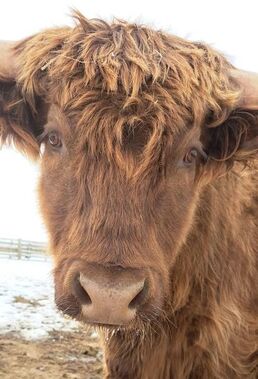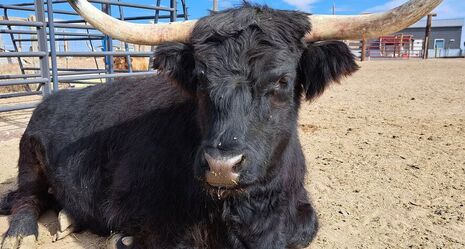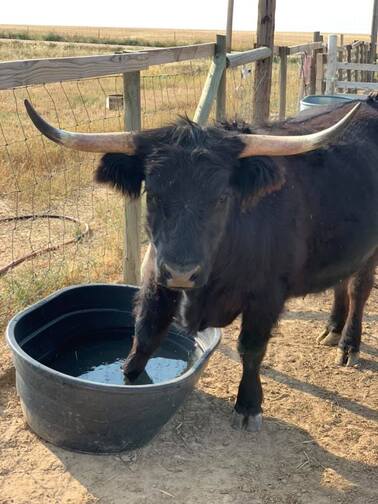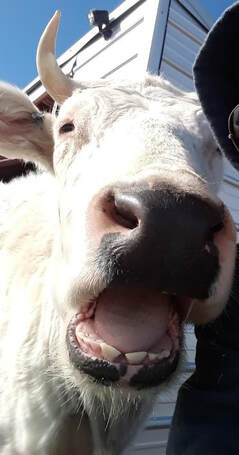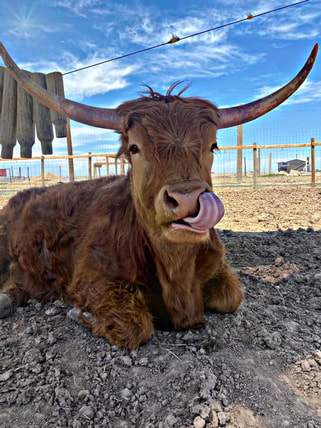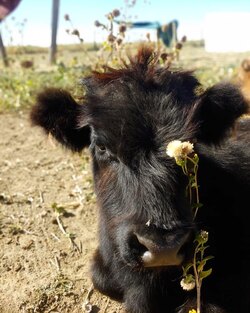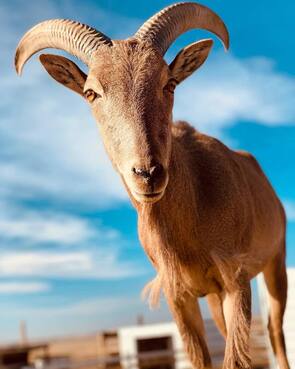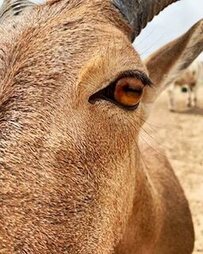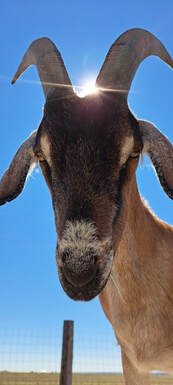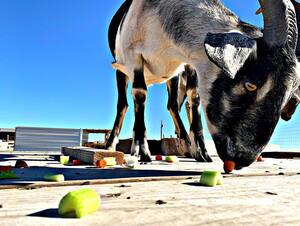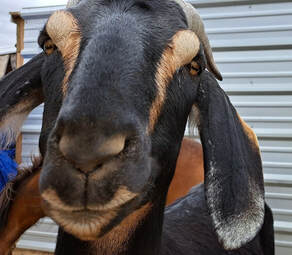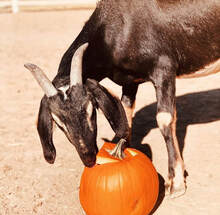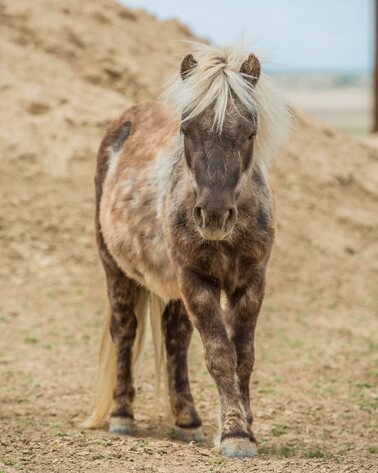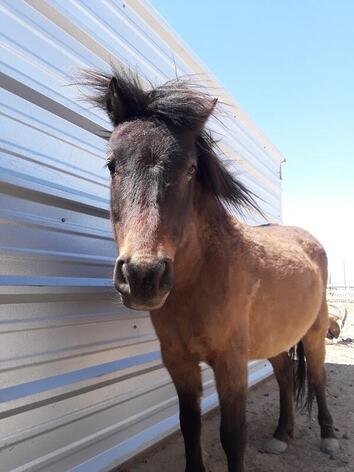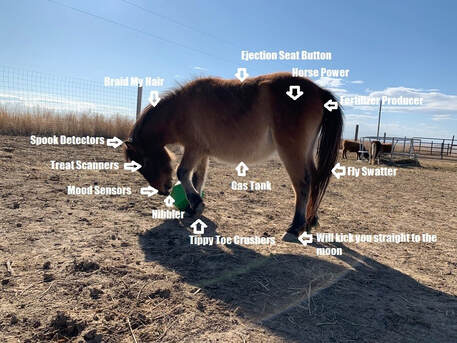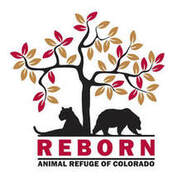Livestock
|
Carmel - aka "Mel"
I enjoy being in the shade, I'm the typical ginger that can't tolerate the sun too long. I'm friendly and love to play with my "sister", Baby - she thinks I'm her jungle gym. Being brushed feels fabulous.
Vanilla - aka "Nilla"
I'm told I'm huge... roughly 5'5" at the top of my back. I'm very sweet and playful though. I'm vocal when I want attention. I'm very curious about everything and like to observe what's going on. I love to give kisses to my humans and my brothers. I love a good scratch and brush anywhere and treats are very exciting.
|
Walnut - aka "Wally"
I prefer to keep to myself for the most part and like quiet attention; I'm a bit shy with new people. I don't always like to share my food and am vocal when I want something. I love to be brushed. I also like to lay on my side and take naps in the sun.
Cocoa
I like to watch what is going on. A nap in the sun is nice. I LOVE to be brushed so much and get a bit jealous if I have to wait my turn. I also like when my humans play music for me.
|
Steers:
Mel, Wally and Cocoa are Mini Highland Steers. A Scottish breed of rustic cattle. Highlands have a long shaggy double coat to help withstand intemperate conditions. They also have long, wide horns that they use to scratch their backs and to dig through snow to find buried plants.
Highlands can live up to 20 years, which is longer than most other cattle breeds.
Bulls/Steers weigh up to 1,800 pounds and Cows/Heifers weigh up to 1,100 pounds.
Highlands are not moo-dy. They have great temperaments and are friendly.
Mel is the typical red color most seen today due to Queen Victoria preferring the red highlands, which resulted in selective breeding.
Cocoa is a black color which is a more rare color of Highland now, due to selective breeding to please Queen Victoria.
Vanilla (Nilla) is Holstein Steer, which is a typical black and white dairy cow. Certain Holstein breeds can weigh 2,500 pounds and be over 6 feet tall. HOLY COW that’s big. Nilla is definitely large. Good thing he does not know it.
Mel, Wally, Cocoa and Nilla were being sold at a slaughter auction in Oklahoma when they were between 2-4 months old. Reborn specifically drove to Oklahoma to save some animals from that fate.
They were rescued June 8, 2019 with their "sister" Sheep, Baby.
Mel, Wally and Cocoa are Mini Highland Steers. A Scottish breed of rustic cattle. Highlands have a long shaggy double coat to help withstand intemperate conditions. They also have long, wide horns that they use to scratch their backs and to dig through snow to find buried plants.
Highlands can live up to 20 years, which is longer than most other cattle breeds.
Bulls/Steers weigh up to 1,800 pounds and Cows/Heifers weigh up to 1,100 pounds.
Highlands are not moo-dy. They have great temperaments and are friendly.
Mel is the typical red color most seen today due to Queen Victoria preferring the red highlands, which resulted in selective breeding.
Cocoa is a black color which is a more rare color of Highland now, due to selective breeding to please Queen Victoria.
Vanilla (Nilla) is Holstein Steer, which is a typical black and white dairy cow. Certain Holstein breeds can weigh 2,500 pounds and be over 6 feet tall. HOLY COW that’s big. Nilla is definitely large. Good thing he does not know it.
Mel, Wally, Cocoa and Nilla were being sold at a slaughter auction in Oklahoma when they were between 2-4 months old. Reborn specifically drove to Oklahoma to save some animals from that fate.
They were rescued June 8, 2019 with their "sister" Sheep, Baby.
Fun Facts:
|
Baby
|
I like being the boss of my brothers. My brother Mel is a ton of fun to climb on. I'm sweet. I love to jump, climb, chase dogs and ATV's and my favorite this is mud, dirt and water baths.
|
Sheep:
Baby is an Aoudad Sheep, otherwise known as a Barbary Sheep. They are native to the Rocky Mountains in North Africa. They have since been introduced in North America, Southern Europe and elsewhere.
Aoudad sheep can weigh up to 300 pounds.
Aoudad Sheep are trophy hunted a lot.
Baby was being sold at a slaughter auction in Oklahoma when she was between 2-4 months old. Reborn specifically drove to Oklahoma to save some animals from that fate. Baby was rescued June 8, 2019 with her cattle "brothers".
Baby is an Aoudad Sheep, otherwise known as a Barbary Sheep. They are native to the Rocky Mountains in North Africa. They have since been introduced in North America, Southern Europe and elsewhere.
Aoudad sheep can weigh up to 300 pounds.
Aoudad Sheep are trophy hunted a lot.
Baby was being sold at a slaughter auction in Oklahoma when she was between 2-4 months old. Reborn specifically drove to Oklahoma to save some animals from that fate. Baby was rescued June 8, 2019 with her cattle "brothers".
|
Fun Facts:
They have very good eyesight They darken with age and have longer hair on their neck. They have scent glands under their tail. They are very good jumpers and can jump over 7 feet standing. Although females are more aggressive than the males, Baby is very sweet and they overall have a friendly temperament. Their horns continue to grow throughout their life. |
|
Simon
I like to be the leader. Food is my focus. My best friend is Alvin - we are always together. I'm curious and like explore new things. I love treats.
|
Alvin
I'm pretty shy and am usually with my brother Simon all the time. I love treats.
|
Theodore - aka "Theo" aka "Teddy"
I love humans. I love to follow them, stand next to them while I eat, get and give kisses and I enjoy brushing and being sung to; it makes me sleepy. I love treats.
|
Goats:
Alvin, Simon, & Theodore are Nubian Goats, which is a British breed. They were developed in the 19th century in Great Britain, but have origins that extend to India and Egypt. The Nubian goat was originally used as a source of milk and meat.
They are known for their large size, facial profile and long drooping lop ears that extend at least one inch beyond the arched roman nose. Their long ears help to keep cool in the warm climate. They have horizontal pupils in their eyes that allow them to have a wider range of peripheral vision to watch for predators.
Females can weigh up to 240 pounds and males can weigh up to 310 pounds.
They have a friendly temperament and are quiet when content and vocal when they want attention.
Alvin, Simon and Theo all came to us on August 10, 2019. They were roughly 4 months old at the time. Their owner's home was foreclosed on and she said she would sell them for meat if they were not taken ASAP. Fortunately, a concerned person reached out to Reborn hoping we would be able to care for all 3 brothers and even donated to their care.
Alvin, Simon, & Theodore are Nubian Goats, which is a British breed. They were developed in the 19th century in Great Britain, but have origins that extend to India and Egypt. The Nubian goat was originally used as a source of milk and meat.
They are known for their large size, facial profile and long drooping lop ears that extend at least one inch beyond the arched roman nose. Their long ears help to keep cool in the warm climate. They have horizontal pupils in their eyes that allow them to have a wider range of peripheral vision to watch for predators.
Females can weigh up to 240 pounds and males can weigh up to 310 pounds.
They have a friendly temperament and are quiet when content and vocal when they want attention.
Alvin, Simon and Theo all came to us on August 10, 2019. They were roughly 4 months old at the time. Their owner's home was foreclosed on and she said she would sell them for meat if they were not taken ASAP. Fortunately, a concerned person reached out to Reborn hoping we would be able to care for all 3 brothers and even donated to their care.
|
French Fry - aka "Frenchie"
I'm a sweet gal. I like to go for walks with my humans, I like to be be brushed and play with my treat ball.
|
Eclair
I love to be a free spirit, and doing things on my terms. I can be a stinker at times, but also very sweet. I like to go walks and runs. I love treats.
|
Mini Horses:
French Fry and Eclair are Mini Horses, which originated in Europe. Eclair is Bay color and French Fry is Palomino. They are a hardy horse that lives longer than the average horse, including full-sized breeds. They can live up to 35 years.
Miniature horses are actually bred to look just like tiny versions of a full sized horse, rather than a pony, and typically have the more refined features of a larger horse.
They can weigh up to 350 pounds.
They are friendly, gentle and playful.
Eclair and French Fry were displaced with 6 other horses during Hurricane Harvey in Houston and were the remaining 2. They were rescued by SPCA and were then taken to a rescue in Pueblo, CO for temporary care. They needed a long-term loving home, and came to us. We rescued them September 15, 2019.
French Fry and Eclair are Mini Horses, which originated in Europe. Eclair is Bay color and French Fry is Palomino. They are a hardy horse that lives longer than the average horse, including full-sized breeds. They can live up to 35 years.
Miniature horses are actually bred to look just like tiny versions of a full sized horse, rather than a pony, and typically have the more refined features of a larger horse.
They can weigh up to 350 pounds.
They are friendly, gentle and playful.
Eclair and French Fry were displaced with 6 other horses during Hurricane Harvey in Houston and were the remaining 2. They were rescued by SPCA and were then taken to a rescue in Pueblo, CO for temporary care. They needed a long-term loving home, and came to us. We rescued them September 15, 2019.
|
Fun facts:
Horses can sleep both lying down and standing up. They are capable of seeing nearly 360 degrees at one time. Their ears point where they are looking and they cannot breathe through their mouth. Horses use their ears, eyes and nostrils to express their mood and communicate their feelings through facial expressions. They will not lie down simultaneously because at least one will act as a look-out to alert its companions of potential dangers. Horses drink at least 25 gallons of water a day. You can tell if a horse is cold by feeling behind their ears. If that area is cold, so is the horse. |
Temporary Residents:
|
|
Moose and Dinka were quarantined with us at reborn for 30 days and then they moved to their forever home at Good Life Refuge. We are so happy for these two and very much enjoyed taking care of them.
Its so rewarding to build another relationship with another great organization to help save animals. When we all have the same goal and work together, we can achieve greatness! |
Click to set custom HTML
